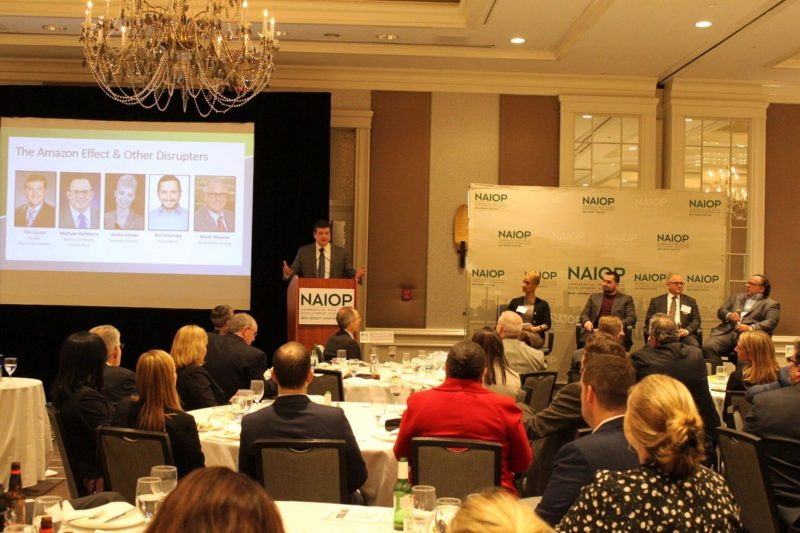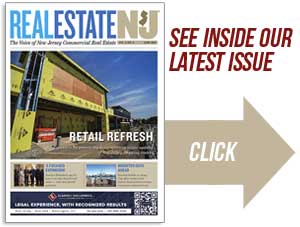NAIOP New Jersey recently hosted its annual meeting and commercial real estate outlook event at the Hilton Short Hills — Photo by Karen Ravensbergen/Courtesy: Caryl Communications
By Joshua Burd
There is no denying that Amazon has been a disruptive force in commercial real estate. That even goes for economic development leaders in Newark, who were impacted in a major way by the technology giant’s high-profile search for a second headquarters location.

“It really changed how we thought about corporate attraction,” said Aisha Glover, the CEO and president of the Newark Alliance, who led the city’s recent bid to land Amazon HQ2 and helped it wind up as a finalist for the project. She also said the process changed “how we were redirecting and leveraging the funds that were already in the city and the momentum that was there to make sure that we were putting together a strong package that, quite frankly, we can use over and over again and not really look at it as this kind of one-off.”
The HQ2 sweepstakes had an outsized impact on markets across the country, but it’s far from the only disruptor of commercial real estate. A panel of industry experts said as much last week, citing everything from ridesharing services and automation to changing corporate and consumer preferences.

“The disruptor is personal choice,” said Tim Lizura, the New Jersey Performing Arts Center’s senior vice president of real estate and capital projects, who moderated the panel discussion at the Hilton Short Hills.
Hosted by NAIOP New Jersey, the Jan. 24 program came as part of the association’s annual meeting and commercial real estate outlook event. And it brought together several top industry executives and local leaders, who highlighted changes across several asset classes.
Mark Shearer, a senior vice president with Rockefeller Group, noted that returns made by e-commerce shoppers are impacting what was already a disruptive force. Return centers are largely concentrated in the center of the country, he said, but “it would not surprise me over the next five to 10 years” to see the facilities brought closer to population centers such as the Northeast.
The key for retailers will be to maximize the value of their footprint in those areas, where real estate “is exponentially more expensive,” he said. The growth of automation and multistory distribution centers could provide that opportunity, especially for a leading company in New Jersey such as Amazon.

“They have an existing 12 million-square-foot footprint here,” Shearer said, “so if they open two new centers at 4 million feet, (for) those existing centers, it would not surprise me to see those start to become return centers, where the stuff is actually kept much closer
to the customer.”
Automation also has the potential to solve the labor shortages in many of the region’s top industrial submarkets, Shearer said.
“You’re seeing capital deployed into these buildings,” said Shearer, Rockefeller’s regional development officer for New Jersey and Pennsylvania. For instance, FedEx’s new hub in the Lehigh Valley, which opened last fall, is a “two-touch facility” — in that workers are handling packages only when they come off the truck and when they go onto the next truck.
“It’s never touched by human hands as it goes through the rest of that facility,” Shearer said. “I think you’re going to see more and more of that, which is going to make for less of a reliance on local labor and really just make the system more efficient.”

As the panelists noted, the changing tastes of office users and their workers have also disrupted commercial real estate. PrimeWork CEO and founder Avi Orlansky, whose firm provides shared office space in suburban submarkets, noted that the first co-working venues grew from the needs of lone entrepreneurs who did not require a large footprint.
More recently, though, co-working has begun to serve small to midsized businesses that “are looking to grow, but they need the facilities and the amenities to do so.”
“A lot of people don’t want to sign long-term contracts and they’re not looking to take their own space,” Orlansky said. “And the overall amenities and the overhead that’s required to run a space is kind of daunting, so they don’t want to get involved in that. They want to keep their cash flow as vibrant as possible and that’s where co-working comes into effect.”
The spaces have also become increasingly appealing to larger companies in the continued quest to shrink footprints and create a more efficient work environment, the panelists said. That has paved the way for users such as WeWork to expand its reach across the office sector.

Michael DeMarco, CEO of Mack-Cali Realty Corp., said that landing such a company and its target customer still requires a landlord to create an attractive overall building. The real estate investment trust has sought to do so with major investments in the common spaces and shared amenities at its waterfront and high-end suburban office properties.
“It has a good product line,” DeMarco said, referring to shared office space providers, “but they still reside in traditional buildings and they reside with the same problems that we have with most tenancy, which is that the building has to have a certain vibrancy to it.
“Now you have to have a building that has the dynamic features to it that attracts that crowd.”
Both co-working companies and corporate users are now seeking densities that are dramatically different from the past, he said. That also means that landlords must invest in utilities, facilities and buildings systems that can handle the extra bodies and extra equipment.
“Whenever we go to higher density, which is a disruptor, you lead to a concept of ‘Does the building support it?’ ” DeMarco said. “So when buildings were done at four per thousand, bathrooms had a certain size to them, the air conditioning systems had a certain size to them, the electricity wattage per square foot was done at a certain level.”










